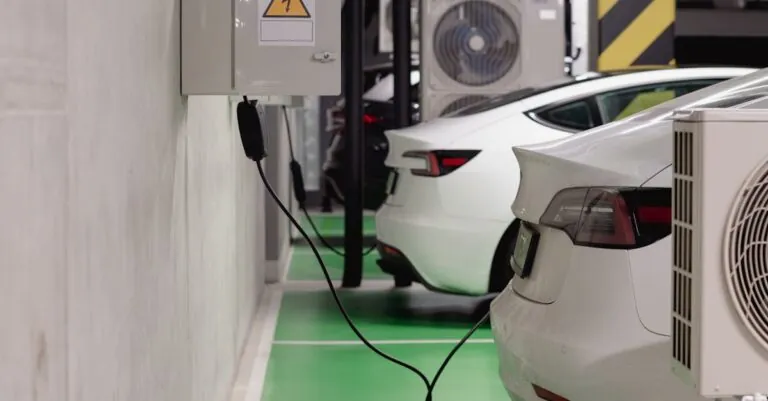The future of driving’s revving up, and it’s not just the engines that are changing. Next-gen vehicle propulsion is here to take us from zero to sixty in a whole new way. Forget about the old gas-guzzlers that leave a trail of fumes; these innovative systems promise to deliver power and efficiency while keeping Mother Earth a little happier.
Table of Contents
ToggleOverview of Next-Gen Vehicle Propulsion
Next-generation vehicle propulsion systems emphasize efficiency and sustainability. Electric, hydrogen fuel cell, and hybrid technologies play crucial roles in this transformation. Electric vehicles (EVs) increasingly dominate the market, with advancements in battery technology offering longer ranges and faster charging times.
Hydrogen fuel cells convert hydrogen into electricity through an electrochemical reaction, producing water as the only byproduct. Numerous automakers pursue hydrogen solutions, recognizing their potential for zero emissions. Moreover, hybrid systems combine conventional internal combustion engines with electric propulsion, improving fuel efficiency and reducing emissions.
Innovative concepts like magnetic levitation and ultracapacitors gain attention for their ability to enhance propulsion performance. Magnetic levitation systems eliminate friction, allowing for smoother ride experiences. Ultracapacitors provide rapid energy discharge and recharge capabilities, supporting improved vehicle acceleration.
The integration of advanced materials also contributes to vehicle weight reduction, enhancing efficiency further. Lightweight composites and metals offer robust structural integrity while minimizing energy consumption.
Using artificial intelligence and smart technologies, next-gen propulsion systems enhance vehicle performance and user experience. These technologies allow for optimized energy use, efficient route planning, and improved safety features.
Regulatory support facilitates this transition, with many governments setting ambitious targets for reducing greenhouse gas emissions from transportation. Incentives for electric and hydrogen vehicles drive adoption rates, creating a competitive marketplace where innovation flourishes.
Next-generation vehicle propulsion continues to evolve, laying the groundwork for a sustainable transportation future. As technologies advance and consumer demand grows, this sector adapts to new challenges and possibilities, reshaping the landscape of mobility.
Types of Next-Gen Vehicle Propulsion Systems
Next-generation vehicle propulsion systems represent a key shift towards more sustainable transport solutions. These technologies include electric propulsion, hydrogen fuel cells, and biofuels.
Electric Propulsion
Electric propulsion systems dominate the current market, driven by advancements in battery technology. These batteries enable longer ranges, with many electric vehicles (EVs) exceeding 300 miles on a single charge. Fast charging stations have increased, reducing downtime for drivers. Significant reductions in greenhouse gas emissions accompany the growth of EVs, making them a cleaner alternative for personal and public transportation. Various automakers are investing in and expanding electric vehicle offerings, leading to a competitive landscape that encourages innovation and consumer choice.
Hydrogen Fuel Cells
Hydrogen fuel cells convert hydrogen into electricity through a chemical process, producing only water vapor as a byproduct. This technology presents a strong zero-emission alternative, particularly for heavy-duty vehicles and longer routes. Numerous automakers are investing in hydrogen infrastructure, addressing challenges related to storage and distribution. Fueling times for hydrogen vehicles are comparable to traditional gasoline. The scalability and efficiency of hydrogen fuel cells position them as a significant player in the quest for cleaner transportation solutions.
Biofuels
Biofuels offer an alternative to fossil fuels by utilizing renewable resources such as vegetable oils and waste materials. These fuels can power existing internal combustion engines, facilitating a smoother transition to greener technology. Various types of biofuels, including biodiesel and ethanol, have demonstrated effectiveness in reducing carbon emissions. Government incentives and research into sustainable production methods enhance the viability of biofuels as part of the broader energy landscape. The integration of biofuels complements electric and hydrogen systems in achieving sustainable transportation goals.
Advancements in Technology
Next-generation vehicle propulsion showcases significant advancements in various technologies, enhancing efficiency and sustainability in transportation.
Battery Technology
Advances in battery technology continue to drive the electric vehicle market. Current lithium-ion batteries now frequently provide ranges exceeding 300 miles on a single charge. Moreover, developments in solid-state batteries promise even greater energy densities and faster charging capabilities. Many manufacturers invest heavily in research to improve battery life and reduce costs. Enhanced thermal management systems further increase battery safety and performance. Collectively, these innovations result in longer-lasting, more accessible electric vehicles that meet consumer demands more effectively.
Fuel Cell Efficiency
Fuel cell efficiency has improved significantly, with hydrogen fuel cells emerging as a viable zero-emission alternative for heavy-duty applications. Optimized membrane technologies enhance power output while reducing operational costs. Many automakers are exploring hybrid fuel cell designs to maximize efficiency across various driving conditions. Quick refueling capabilities now rival those of traditional gasoline vehicles, making hydrogen a competitive choice for long-haul transportation. Ongoing developments in hydrogen production, including low-carbon methods, ensure a cleaner supply chain. Overall, the focus on fuel cell advancements is paving the way for efficient commercial and personal vehicles.
Environmental Impact
Next-generation vehicle propulsion has a significant environmental focus, aiming for reduced carbon footprints and enhanced sustainability. Advances in technology drive the shift towards cleaner transportation options.
Reducing Carbon Emissions
Electric vehicles (EVs) address carbon emissions with their zero tailpipe output. These vehicles contribute to an overall reduction in greenhouse gases, especially when powered by renewable energy sources. Studies show that compared to traditional gasoline vehicles, EVs can reduce carbon emissions by up to 70 percent. Hydrogen fuel cells also offer zero emissions, emitting only water vapor. This technology is particularly effective in applications requiring longer-range travel, enabling further reductions in fossil fuel dependency. Automakers continue to innovate in battery technology and hydrogen applications, ensuring ongoing improvements in efficiency and emissions reduction.
Sustainability Considerations
Sustainability extends beyond vehicle operation, touching on production and lifecycle management. The materials used in manufacturing next-generation vehicles often come from sustainable resources, decreasing the environmental impact of extraction processes. For example, advancements in battery recycling methods significantly reduce waste and environmental harm. Biofuels serve as a sustainable alternative to fossil fuels, utilizing waste materials and avoiding competition with food crops. Policies encouraging renewable resource utilization further reinforce this approach. As the industry moves forward, sustainable practices in production and energy generation will become more commonplace, shaping the future of automotive technology.
Challenges and Limitations
Next-generation vehicle propulsion faces various challenges that need addressing for widespread adoption. Key obstacles include infrastructure development and cost accessibility.
Infrastructure Development
Developing infrastructure for electric and hydrogen fueling is crucial for supporting next-generation propulsion systems. Many regions currently lack sufficient charging stations and hydrogen refueling sites. Collaborative efforts between governments and private entities can accelerate the establishment of these facilities. Upgrading existing energy grids to support increased demand also plays a significant role. Regions with limited charge point networks may hinder the adoption of electric vehicles. Ensuring a comprehensive charging and refueling infrastructure fosters consumer confidence and usability.
Cost and Accessibility
Cost remains a significant barrier in the adoption of next-generation propulsion technologies. Electric vehicles, while becoming more affordable, still present higher initial prices compared to traditional gasoline vehicles. Incentives from governments can increase accessibility, yet additional funding is necessary to support consumers in underserved areas. Participation from automakers in developing lower-cost alternatives also proves essential. Fostering competition among manufacturers and investing in innovative technologies can reduce costs over time. Furthermore, expanding access to charging and refueling stations in rural areas addresses accessibility concerns, making these technologies more appealing to a broader audience.
Next-generation vehicle propulsion represents a pivotal shift in the automotive industry. With a strong emphasis on sustainability and efficiency, these innovations are poised to redefine transportation. Electric vehicles are leading the charge with advancements in battery technology and infrastructure development. Hydrogen fuel cells are emerging as a viable alternative, particularly for heavy-duty applications, while biofuels offer a transitional solution for existing engines.
As these technologies continue to mature, they promise significant reductions in carbon emissions and a cleaner future for mobility. The collaboration between governments and private entities will be essential in overcoming challenges related to infrastructure and cost accessibility. Embracing next-gen propulsion technologies not only enhances performance but also aligns with global efforts to create a more sustainable world. The future of transportation is bright, and these advancements are just the beginning.




